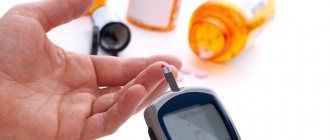Accuracy of home blood analyzers
The functionality of most modern devices is not limited to hemoglobin measurement. They can calculate the concentration of sugar and cholesterol. Because of this, many doubt how accurate the results of such a test will be. Such devices first began to be used at home back in the 90s. Since their introduction, they have undergone many changes and upgrades, so the results of analyzers released in recent years will be several times more accurate than previous models.
Manufacturers indicate possible errors in the instructions. To minimize it, you must follow all instructions for use. On average, the hemoglobin content in the blood according to home tests can differ by 10%-15% from laboratory tests. The maximum error can be 20%, so do not be alarmed if the blood sampling results obtained from your doctor are slightly higher or lower.
Causes of high and low hemoglobin levels
An increased hemoglobin level in women negatively affects the consistency of the blood (it becomes thicker), as a result of which movement slows down and the cells do not receive oxygen. If you do not respond to an increase in hemoglobin in time, blood clots form in the vessels. An increase in the indicator may be due to various diseases, such as: intestinal obstruction; diseases of the cardiovascular system; blood diseases (leukemia).
A high rate can also indicate various physiological changes and disorders, such as: excessive physical activity, living in high altitudes; hemoconcentration (blood thickening), caused by dehydration of the body - dehydration, or extensive burns. In such cases, the hemoglobin level, after eliminating these causes, returns to normal over time. Symptoms indicating an increase in hemoglobin include: deterioration of brain function; decreased performance; lack of concentration; fatigue; drowsiness or insomnia; lack of appetite; excessive irritability. If these symptoms appear, you should consult a doctor.
In men, an increase in hemoglobin levels can also be associated with smoking, intense training, physical activity and severe stress. Signs of high hemoglobin in men are:
- increased fatigue;
- frequent headaches;
- dizziness, fainting;
- drowsiness;
- loss of appetite.
This symptomatology is characteristic of a number of diseases: respiratory and heart failure; polycystic kidney disease; erythremia. The amount of hemoglobin in the blood may fluctuate due to severe dehydration.
The causes of low hemoglobin can be: anemia of various origins, including those caused by various diseases; impaired blood circulation; thyroid diseases; strict dietary nutrition; emotional fatigue; alcoholism.
Rules for using a home blood analyzer
Most portable research instruments operate on the same principle. Electrochemical analysis requires special plates, which manufacturers add to starter kits. When they run out, an additional kit can be purchased at any pharmacy. Which plates are used for each model is indicated in the operating instructions.
Attention! The analyzer does not allow you to independently diagnose the disease. Such tests are needed only to monitor your health in order to understand when you need to see a doctor.
For the data to be reliable, you need to:
- draw blood from a finger, because there blood circulates more actively than in the thigh or shoulder;
- Before piercing, rinse your hands under water and treat the skin with an antiseptic, otherwise dirt may affect the results;
- To ensure that blood flows easily, you need to massage your finger before the procedure to increase the flow;
- dry your hands after washing, because... excess moisture can spoil the results;
- make the puncture not in the very center of the pad and not too deep so as not to damage the tissue;
- Do not squeeze your finger, because because of this, interstitial fluid will enter the analyzer;
- take out the test strip before the procedure so that dust particles do not get on it;
- change puncture sites, because the wound heals worse if it is constantly damaged;
- use the tip of the strip (blood is easily absorbed over the entire area).
How to choose a home blood analyzer
A model with an automatic scarifier is suitable for home use, because... skin puncture. Doing this yourself is more difficult and can damage soft tissues. The accuracy guaranteed by the manufacturers is important. The error is indicated in the instructions or description of the device. The minimum indicators that can be found among home analyzers are 5%.
Functionality may also vary. Most often, devices that can determine content are chosen:
- ketone bodies;
- cholesterol;
- glucose;
- hemoglobin;
- fat
Home method for measuring hemoglobin
Often those who actively monitor their health develop distrust of portable gadgets due to the difference in results from laboratory studies. This problem arises because preparation for taking tests in a clinic is done subconsciously. At home, a person attaches less importance to the same check, which means he can perform actions the day before that affect the result. For example, hemoglobin levels increase due to smoking, and low levels appear due to an unbalanced diet.
To ensure that the test is reliable, before the procedure:
- You can’t smoke (at least an hour in advance) and drink alcohol (in a day);
- refrain from eating fatty, sweet and spicy foods (it is better to do the test in the morning, on an empty stomach);
- you need to take a comfortable sitting position;
- You cannot do hard physical work.
Attention! After surgery, you can do a test only a month later, otherwise your hemoglobin levels will be low.
MCH (Mean Corpuscular Hemoglobin) - average hemoglobin content in a red blood cell
Interchangeable parameters
MCH reflects the mass of hemoglobin in the “average” red blood cell. This parameter can be calculated using hemoglobin and the number of red blood cells:
MCH (pg) = Hb (G/l)/RBC(·1012/l).
MCH in an erythrocyte and the previously used CP (color indicator) express the same characteristic of cells - the average amount of hemoglobin in erythrocytes. But the first indicator gives the absolute value in picograms, and the second - the hemoglobin content in red blood cells in arbitrary units.
Since these two indicators completely replace each other, there is no need to calculate the CPU. (Of course, if the laboratory has a hematology analyzer, it will calculate the MCH automatically). In addition, MCH in an erythrocyte is a more objective parameter than CP. After all, the second does not reflect the synthesis of hemoglobin and its content in the erythrocyte.
Independent indicator
An increase in MCH above 34 pg (hyperchromia) depends solely on an increase in the volume of red blood cells, and not on their increased saturation with hemoglobin. MCH in an erythrocyte is an extremely stable indicator and for adults does not depend on age, gender, or race. The coefficient of variation of this parameter in patients is 5-6%.
As a diagnostic parameter, MSI is secondary and has no independent diagnostic value. It correlates with the MCV and MCHC values. All conditions that contribute to a decrease in volume, an overestimation of the number of red blood cells and an underestimation of hemoglobin also lead to a decrease in the hemoglobin content in the red blood cell.
Clinical and diagnostic value
| Promotion | Decline |
|
|
How to choose the right device for analyzing blood biochemistry
The first criterion is convenience. If a person plans to take the device with him, it should be compact. Some sets are sold immediately with bags and carrying cases. For older people, hemoglobin analyzers with a minimum set of functions are suitable: this will make it easier to understand the controls. It is also important to determine what exactly the device is supposed to measure. Modern devices can analyze not only hemoglobin concentration, but also glucose, cholesterol and other components.
The ability to purchase additional strips may be decisive. They are easier to find for popular models. It is better to take a kit in which they are already included, otherwise at the first measurement it will turn out that consumables must be purchased separately. If you need to monitor your hemoglobin level constantly, models that provide the ability to save past results are suitable. The number of such entries depends on the memory size.
Attention! All gadgets have a warranty period. During what period can you receive free repair and replacement of a faulty analyzer?
Determining the amount of protein using a hemoglobinometer
Devices that measure the amount of hemoglobin in the blood are called portable. They have an automatic calibration function. A blood sample is collected using a classic laboratory method: about 20 μl of venous or capillary blood is drawn using a syringe with a needle. To prepare a photometric sample, the hemoglobin cyanide method is used.
The modern technique is recommended by WHO and has been used in medicine for forty years. The substance must be diluted in a ratio of 1 to 251 (this is done by a laboratory assistant). To prepare the sample, you will need five milliliters of reagent. The duration of sample preparation varies from 15 to 20 minutes and directly depends on the selected reagent used for analysis. The required sample volume for photometry is 2-4 ml.
To determine the amount of hemoglobin in the blood, you need to place a cuvette with a sample in the hemoglobinometer cell. After a few seconds, the iron protein concentration will appear on the display. The device automatically determines the amount of hemoglobin. It is not forbidden to shake it, heat it, and even turn it on before measuring the indicator (it turns on and off automatically).
After lowering the cuvette into the cell, the device automatically starts, measures the hemoglobin concentration and displays the result on the monitor. When the cuvette is removed from the hemoglobinometer, the device turns off. Repeated measurement is possible within 2-3 seconds after turning off the device.
Overview of devices for measuring hemoglobin
There are many models that can replace a home laboratory for blood testing. They are highly accurate and have an error of no more than 20%. They help determine your health status. Conducting research with such devices is simple: they do not require special skills or knowledge. All consumables are sold in regular pharmacies: you don’t have to look for them in specialized stores.
Easy touch
These devices are considered the most popular for home blood testing. They can determine the content of hemoglobin, cholesterol and glucose. Easy touch is suitable for people suffering from:
- anemia (of any etiology);
- diabetes (type I and II);
- pathologies of the cardiovascular system;
- hypercholesterolemia;
- thrombosis;
- atherosclerosis.
Easy touch is completely portable. For the procedure you do not have to connect to the network: the device is powered by batteries. Manufacturers guarantee an error of no more than 5%, which is considered a good result for home research. You can buy such a device at a price of 4,500 rubles. There are two versions of the device: GCU and GChb. The first one measures only glucose and total cholesterol, so only the second model is suitable for determining hemoglobin concentration. The strips are also capable of analyzing the level of uric acid in the blood: other devices do not have this function.
Attention! The set comes with applicators and a carrying case for travel.
MultiCare-in
The analyzer from Italian manufacturers is one of the most functional. It can be connected to a computer to transfer data to create tables and track analysis changes. To do research, MultiCare-in takes 30 seconds, then all information is stored in memory. In total, the device holds 500 records. The error ranges from 10% to 20%. You can purchase such a device for 5,000 rubles.
Accutrend Plus
This device is made in Germany. He conducts research using photometric analysis of light on consumable strips. The display shows all the information the user needs. Accutrend Plus also has a sound notification function about the readiness of the results and signals if the indicators deviate from the norm. The device stores data on the last 100 scans.
Attention! All devices have test strips that differ in the type of analysis. What research the consumable is intended for is written on the packaging.
You don't have to go to the hospital to get a blood test. You can find out the hemoglobin concentration at home using a special device. It is easy to operate. Even people who are far from technology will understand the interface. Consumables can be purchased at any pharmacy or ordered online. The easiest way to find strips for common models. The devices do not require a network connection and operate on batteries or a built-in rechargeable battery.
Hemoglobin norm in women and men
In women, normal hemoglobin levels range from 120 to 140 grams per liter of blood (abbreviated as g/l). In girls who have not yet turned eighteen years old, the amount of hemoglobin can fluctuate between 110-153 g/l. If a representative of the fair sex is a heavy smoker or is professionally involved in any sport, the norm of this element in the blood can be from 150 to 160 g/l.
During pregnancy, hemoglobin levels most often decrease and can range from 105 to 120 g/l. With age, the hemoglobin concentration is approximately 118-160 g/l. Deviation from the norm may indicate serious diseases, pathological changes and anomalies. If the hemoglobinometer shows a value that is not within the normal range, you should immediately consult a doctor.
Content:
- Hemoglobin norm in women and men
- Causes of high and low hemoglobin levels
- Determining the amount of protein using a hemoglobinometer
- Advantages of a hemoglobinometer
- Preventive and therapeutic measures
The normal hemoglobin level for men aged 18-65 years is 130-173 g/l. For men over 65-70 years old, the age norm is considered to be in the range of 126-174 g/l. If a deviation from the generally accepted standard is detected, you should consult a doctor and, if necessary, undergo an additional series of tests.










